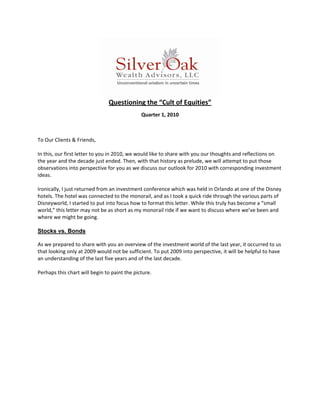
Questioning The Cult Of Equities 022010
- 1. Questioning the “Cult of Equities” Quarter 1, 2010 To Our Clients & Friends, In this, our first letter to you in 2010, we would like to share with you our thoughts and reflections on the year and the decade just ended. Then, with that history as prelude, we will attempt to put those observations into perspective for you as we discuss our outlook for 2010 with corresponding investment ideas. Ironically, I just returned from an investment conference which was held in Orlando at one of the Disney hotels. The hotel was connected to the monorail, and as I took a quick ride through the various parts of Disneyworld, I started to put into focus how to format this letter. While this truly has become a “small world,” this letter may not be as short as my monorail ride if we want to discuss where we’ve been and where we might be going. Stocks vs. Bonds As we prepared to share with you an overview of the investment world of the last year, it occurred to us that looking only at 2009 would not be sufficient. To put 2009 into perspective, it will be helpful to have an understanding of the last five years and of the last decade. Perhaps this chart will begin to paint the picture.
- 4. requires investment advisors to think outside of the traditional geographic and stylistic approach that worked for decades past. Building and managing portfolios using a rear view mirror approach will likely disappoint investors going forward. The traditional building blocks of the diversified global portfolio of 20‐30 years ago will likely be shown to be ineffective going forward. While a U.S.‐centric portfolio may have been logical and based on objective domestic growth statistics at that time, our current Gross Domestic Product – the value of all goods and services produced – is now only 24% of the world’s GDP. The European Union now represents 30%, and the region comprising Asia and the Pacific rim about 27.5% (and growing). For comparison purposes, in 1970 the U.S. represented about 41% globally, and down from almost half of world GDP in 1960. Risk and reward have always been the bedrock analytics upon which portfolios were constructed. The analysis of risk, however, has become much more complicated due to today’s “flatter” world and to the complexity of investments that infuse stock‐like risk elements into fixed income vehicles. The increased global influence of emerging nation economies and their fluctuating currencies add to the multiplicity of risk factors. We believe that there is much compelling evidence supporting our focus on effectively identifying and evaluating risk first and taking a global approach to locating the building blocks that create the most stable foundation for the portfolios we build. Risk & Reward and Asset Allocation Which portfolio would you prefer to have based on these two choices? 1. A 100% portfolio of equities with an expected return of 10%; or 2. A 100% bond portfolio with an expected return of 10% You might initially conclude that both portfolios will produce the same return, so the choice would be moot. However, since the level of volatility of the equity portfolio would be double or triple that of the bond portfolio, these two portfolios are not truly identical. On a risk‐adjusted basis, the bond portfolio clearly would be the better choice. In fact, the bond portfolio would also have a higher compounded return (more capital returned) over a number of years since its rate of fluctuation would be lower. When we design portfolios, we are always mindful of the risk and return trade‐off. Our primary mission in designing portfolios is the protection of capital. Therefore, as we select from various asset classes in our pursuit of a rate of return that will accomplish your long‐term goals, our initial focus is on identifying the total return opportunity of each investment based on its level of risk. In approaching portfolio construction in this manner, we incorporate risk and return analyses as we build a lower volatility portfolio. Over the past 15 months, our asset allocation has included a broad array of fixed income vehicles. Our belief at the end of 2008 was that on a risk/reward basis, most bonds would perform better than stocks. In early 2009, bonds as well as stocks were being priced as if we would be entering another Great Depression. As it turned out, once it became evident that we were only in a Great Recession and a more major disaster was averted, all risky asset classes rebounded. Since in March of 2009 there remained serious questions about our economy, we chose to focus on reaping the excellent returns in the fixed income markets. We are proud of our emphasis on managing risk and creating effective diversification strategies. We continue to be committed to our primary mandate that capital that can’t be replaced